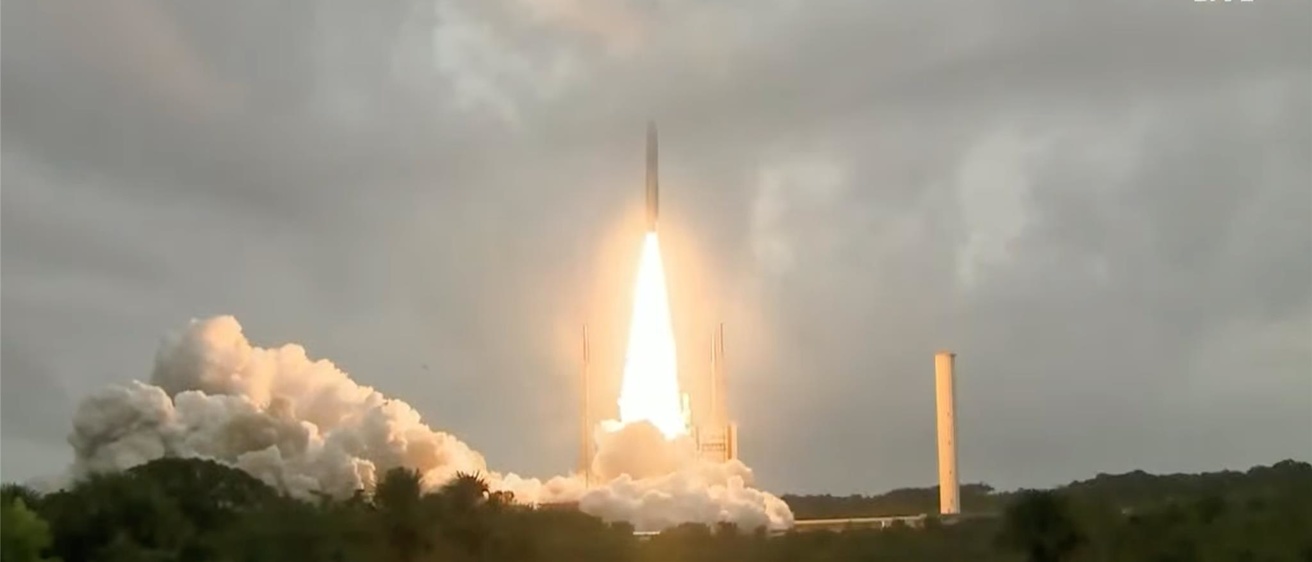A new high-powered, NASA-led infrared telescope with a sun shield the size of a tennis court is set to launch Christmas Day, with expectations of revolutionizing astrophysics by expanding the science around how galaxies formed and enabling a glimpse back in time to billions and billions of years ago.

“It's going to be able to see further and further back in time than Hubble can, to when the first galaxies and maybe even the first stars formed,” University of Iowa astrophysicist and assistant professor Keri Hoadley said, referencing the Hubble Space Telescope that’s been orbiting Earth for nearly 32 years. “It's going to revolutionize our field of astronomy.”
Hoadley is among the scientists worldwide who have applied and eventually hope to use the innovative James Webb Space Telescope — or JWST — in their research over its anticipated seven to 10 years orbiting the sun about 1 million miles from Earth.
“One of the things I’m really interested in is the idea of whether life is present elsewhere,” she said. “JWST is going to be huge in helping us to observe other planets and other star systems that might be promising candidates for where other life might be present.”
One way the 13,600-plus-pound telescope — an international collaboration between NASA, the European Space Agency and the Canadian Space Agency — can inform the potential for life beyond Earth is by taking images of other planets and breaking down the light into different colors indicative of life.
“For example, is there oxygen or water present? Is there methane, which we attribute to the presence of life in some atmospheres?” Hoadley said. “It'll be really the first time we get very detailed, high-quality information about the atmospheres of other planets, and my biggest hope is that we find really good promising evidence of life somewhere else in another system.”
The James Webb Space Telescope will orbit the sun — instead of Earth, like Hubble — pushing it much farther into space. It’s 100 times more powerful than Hubble, and its camera has a focal length of 131.4 meters — nearly 2.5 times the Hubble focal length and 2,620 times the standard camera’s 50 mm focal length.
It’s scheduled to launch between 6:20 a.m. and 6:52 a.m. Iowa time Saturday from Europe’s Spaceport in French Guiana, located in a rainforest-heavy region of South America. The launch was supposed to happen Christmas Eve, but weather delayed it.
“I had an alarm set for the 24th,” Hoadley said, confirming while children might be watching the skies for Santa and his reindeer Christmas morning, she’ll be eagerly awaiting the launch. “This doesn't happen very often.”
As one of “NASA's great observatories,” she said, “This is a really big moment for us. I wouldn't miss it, honestly.”
In addition to shedding light on the prospect for life on other planets and planetary systems, the James Webb technology aims to determine how stars and planets emerged; how systems evolved; and even how the “first galaxies or luminous objects formed after the Big Bang.”
To the question of how a superpowered telescope can enable researchers to actually look “back in time,” Hoadley explained the universe has a finite speed — the speed of light — which is the fastest anything can travel.
“Even looking at the sun, for example, we are only able to see the sun as it was eight minutes ago,” she said. “So, in a way, everything that we see in the sky — even the moon — we are seeing in the past. Because light only travels so fast.”
That means images captured of even neighboring galaxies are thousands to millions of years old, according to Hoadley.
“And with James Webb, we're looking so far into the past we’re looking right at the point when those galaxies started to form,” she said. “And that's all because of the fact that light only travels at the speed of light, and it can’t travel any faster.”
Unlike the Hubble telescope, which has kept kicking for decades, the new Webb scope’s age will be limited by how long its onboard cooling equipment can keep its instruments cold.
NASA reports the longer the infrared light wavelength, the colder detectors need to be to convert light signals into electrical signals — which is necessary to process images. Webb’s tennis court-sized sunshield helps with that.
“The reddest camera — the one that will see the reddest light — has to be kept at a little bit above absolute zero,” Hoadley said.
NASA reports the required temperature is minus-448 degrees Fahrenheit, just above absolute zero — which is the coldest temperature theoretically possible, although “it’s never physically attainable because it represents the total absence of any heat.”
Those extreme temperature demands will limit the telescope’s life, according to Hoadley.
“It makes it a little challenging, but there's a lot of really exciting new technologies that NASA and industry partners have developed to try to make JWST last as long as possible,” she said. “I think the baseline for that is about seven to 10 years. And I think the hope is that it will last longer than that.”
By Vanessa Miller.
Hoadley also commented on the JWST launch on Radio Iowa.
